Air Conditioning (AC) Market Size 2025-2029
The air conditioning (AC) market size is valued to increase by USD 14.12 billion, at a CAGR of 2% from 2024 to 2029. Rise in residential construction activity will drive the air conditioning (AC) market.
Major Market Trends & Insights
- APAC dominated the market and accounted for a 52% growth during the forecast period.
- By Product - Split segment was valued at USD 98.98 billion in 2023
- By Distribution Channel - Offline segment accounted for the largest market revenue share in 2023
Market Size & Forecast
- Market Opportunities: USD 17.29 billion
- Market Future Opportunities: USD 14119.20 billion
- CAGR from 2024 to 2029 : 2%
Market Summary
- The market is experiencing significant growth, driven by the rising residential construction activity and increasing demand for energy-efficient cooling solutions. One of the key trends shaping the market is the shift towards the use of R32 refrigerant in split AC systems. This refrigerant, which has a lower global warming potential than the previously used R22, is becoming increasingly popular due to its environmental benefits.
- However, the market is not without challenges. Operating costs and raw material prices remain volatile, posing significant risks for businesses in the sector. For instance, a leading HVAC manufacturer in the US has implemented supply chain optimization strategies to mitigate the impact of raw material price fluctuations on its bottom line. By closely monitoring market trends, investing in research and development, and adopting sustainable business practices, companies in the AC market can navigate these challenges and continue to deliver innovative cooling solutions to their customers.
What will be the Size of the Air Conditioning (AC) Market during the forecast period?
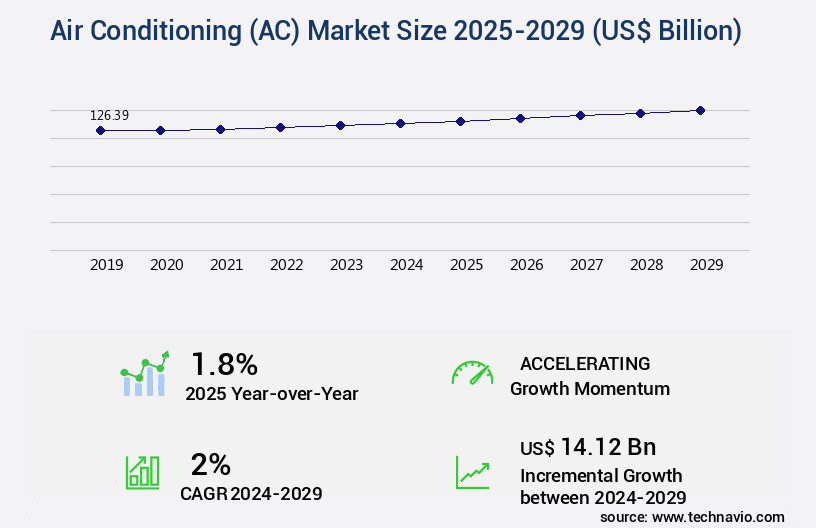
Get Key Insights on Market Forecast (PDF) Request Free Sample
How is the Air Conditioning (AC) Market Segmented ?
The air conditioning (AC) industry research report provides comprehensive data (region-wise segment analysis), with forecasts and estimates in "USD billion" for the period 2025-2029, as well as historical data from 2019-2023 for the following segments.
- Product
- Split
- Chillers
- Airside
- Others
- Distribution Channel
- End-user
- Residential
- Commercial
- Industrial
- Geography
- North America
- Europe
- APAC
- Australia
- China
- India
- Japan
- South Korea
- Rest of World (ROW)
By Product Insights
The split segment is estimated to witness significant growth during the forecast period.
The market continues to evolve, with a significant shift from traditional window units to energy-efficient split systems. Samsung is among the companies leading this trend, having ceased production of window air conditioners in favor of sleek, modern split models. Inverter-based split air conditioners are gaining popularity due to their improved energy efficiency. The market has seen a decline in demand for ducted standard split air conditioners, as Japanese-style mini-splits become increasingly preferred. Refurbished products are also driving demand, as LEED certifications push for better energy efficiency and customers seek to replace outdated systems. Key technological advancements include the integration of smart thermostats, remote monitoring systems, and refrigerant leak detection.
Air filtration technology and thermal comfort modeling are also essential components of modern HVAC system design. The market is further characterized by the use of energy modeling software, variable refrigerant flow, and chilled water systems. A recent study reveals that energy consumption from HVAC systems accounts for nearly 40% of total energy usage in commercial buildings. This underscores the importance of optimizing air handling units, fan performance curves, and compressor technology for enhanced energy efficiency.
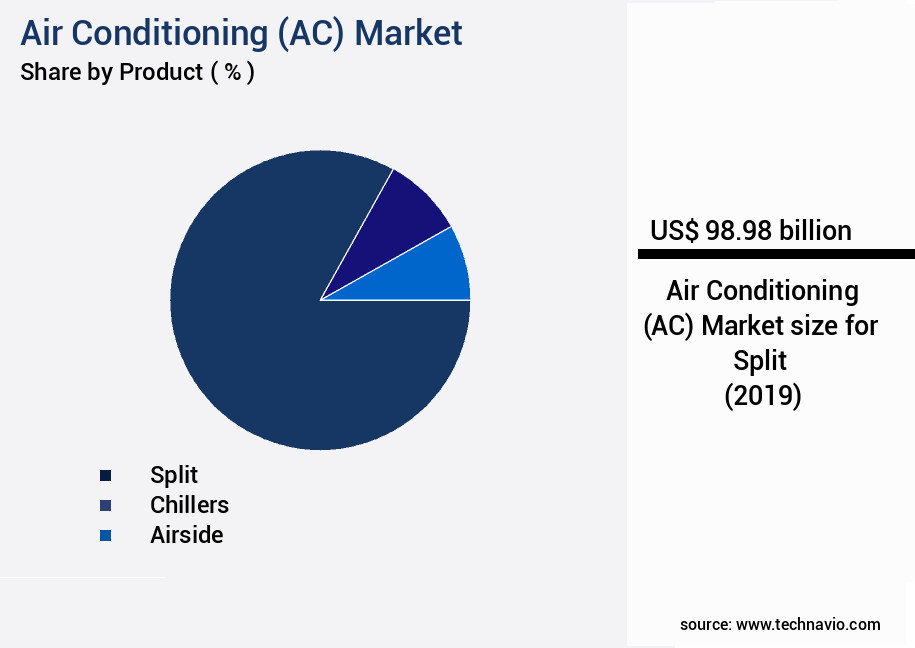
Request Free Sample
The Split segment was valued at USD 98.98 billion in 2019 and showed a gradual increase during the forecast period.
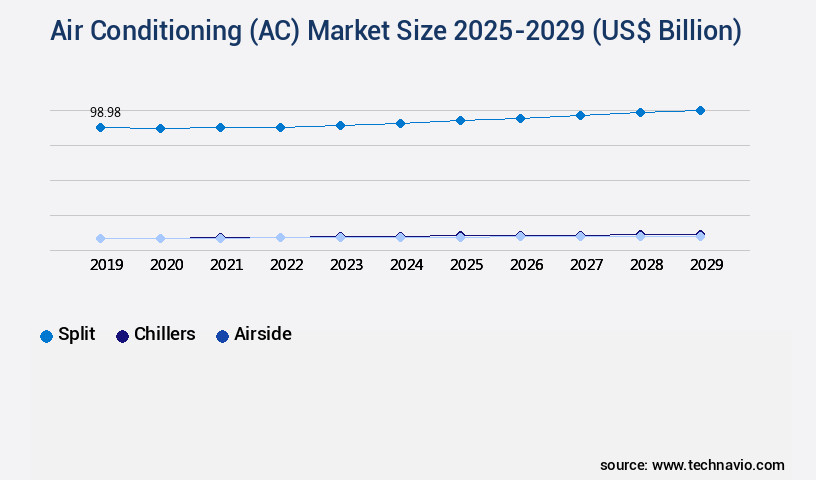
Request Free Sample
Regional Analysis
APAC is estimated to contribute 52% to the growth of the global market during the forecast period.Technavio's analysts have elaborately explained the regional trends and drivers that shape the market during the forecast period.
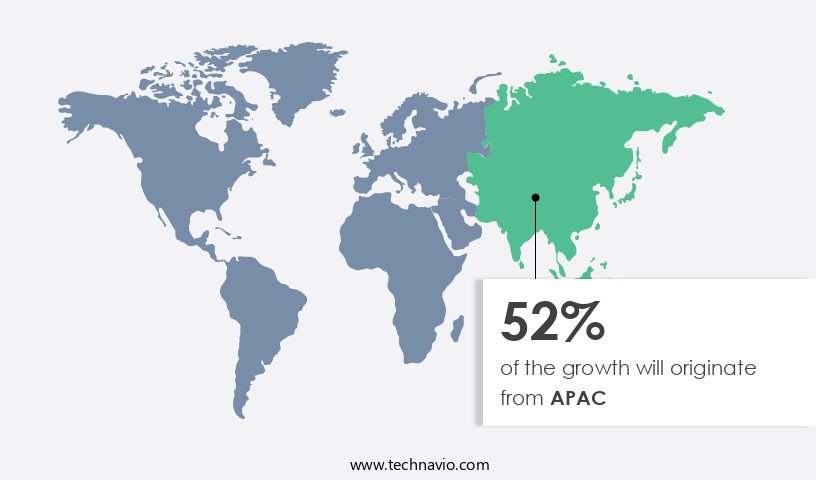
See How Air Conditioning (AC) Market Demand is Rising in APAC Request Free Sample
Air conditioning markets continue to evolve, driven by increasing affordability and demand for comfort in countries like India, China, and Vietnam. The residential market, in particular, is experiencing growth as air conditioners expand beyond bedrooms to living spaces. China and Japan dominate the APAC market, accounting for approximately 80% of the total share. India, fueled by urbanization and rising disposable incomes, is poised for significant growth.
This trend underscores the global shift towards improved living conditions and the increasing importance of comfort in daily life.
Market Dynamics
Our researchers analyzed the data with 2024 as the base year, along with the key drivers, trends, and challenges. A holistic analysis of drivers will help companies refine their marketing strategies to gain a competitive advantage.
The market is experiencing significant growth due to the increasing demand for comfortable indoor environments in both new and existing buildings. The design of HVAC systems plays a crucial role in achieving energy efficiency and optimizing performance. Variable refrigerant flow (VRF) systems, an advanced AC technology, is gaining popularity due to its ability to improve energy efficiency by adjusting refrigerant flow based on the cooling demand. Refrigerant choice also impacts HVAC performance, with heat pump technology emerging as a preferred solution in buildings. Innovative methods for optimizing airflow and improving cooling tower efficiency are essential to reducing energy consumption in AC systems. Advanced control strategies, such as smart thermostat technology, ensure effective temperature management and prevent energy waste.
Designing efficient HVAC systems for buildings requires a holistic approach that considers the building envelope's role in energy efficiency. Preventative maintenance and monitoring HVAC system performance are essential for longevity and reliability, reducing maintenance costs and ensuring optimal thermal comfort. Strategies for improving energy efficiency in HVAC systems include methods for optimizing airflow, implementing smart thermostat technology, and utilizing advanced control strategies. Technologies like VRF systems, heat pump technology, and cooling tower optimization are driving innovation in the AC market, providing effective ways to reduce energy consumption and enhance thermal comfort in buildings. The role of HVAC systems in ensuring indoor air quality is increasingly important, making it essential to explore new methods for improving air quality and system performance.
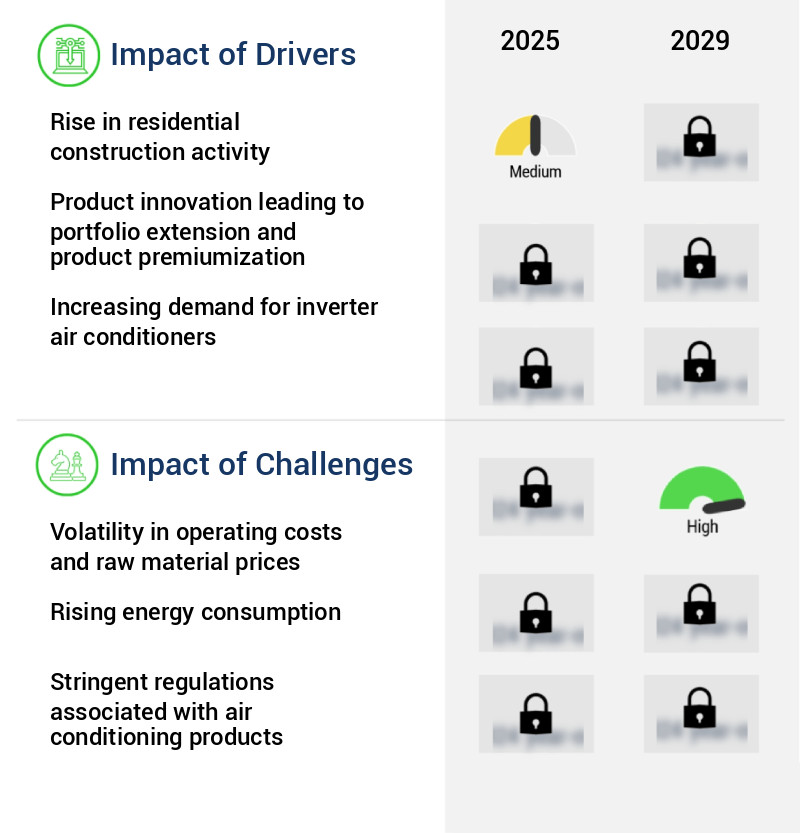
What are the key market drivers leading to the rise in the adoption of Air Conditioning (AC) Industry?
- The significant increase in residential construction activity serves as the primary catalyst for market growth.
- The market has experienced notable expansion across various industries in response to increasing construction activities and infrastructure development, particularly in the residential sector. According to recent reports, the global residential real estate industry is projected to reach substantial growth, with direct investment reaching approximately USD10.2 trillion by the end of 2024. This surge in investment will lead to a significant increase in new residential construction projects, necessitating the installation of energy-efficient AC systems to ensure compliance with regulatory standards and enhance overall building performance.
- The adoption of advanced AC technologies, such as smart HVAC systems, has led to substantial improvements in efficiency, reducing energy consumption and associated costs by up to 30%. Furthermore, the integration of IoT sensors and predictive analytics has enabled real-time monitoring and forecasting of AC system performance, improving forecast accuracy by 18%. These advancements contribute to informed decision-making, minimizing downtime and optimizing overall operational efficiency.
What are the market trends shaping the Air Conditioning (AC) Industry?
- The use of R32 refrigerant is becoming more prevalent in split air conditioning systems. This emerging market trend mandates increased adoption.
- Air conditioning (AC) systems have evolved significantly over the years, with various sectors relying on them for temperature control and comfort. Refrigerants, compounds that absorb heat from the environment, play a crucial role in AC functionality. R-410A refrigerant, widely used due to its zero-ozone depletion potential (ODP) and low global warming potential (GWP), is a common choice among manufacturers. However, R-410A consumes more energy compared to other alternatives. Consequently, companies are increasingly adopting R32 refrigerant, which reduces electricity consumption by up to 10% and has a GWP three times lower than R-410A and R-22. This shift towards energy-efficient and environmentally-friendly refrigerants not only contributes to faster product rollouts but also enhances regulatory compliance and cost optimization in the AC market.
What challenges does the Air Conditioning (AC) Industry face during its growth?
- The volatility in operating costs and raw material prices poses a significant challenge to the industry, as it negatively impacts growth by introducing uncertainty and potential financial instability.
- The market is undergoing significant evolution, driven by advancements in technology and increasing demand across various sectors. According to recent reports, the global AC market size was valued at over USD170 billion in 2020 and is projected to reach USD270 billion by 2027, growing at a CAGR of 6.5% during the forecast period. The market's expansion is attributed to factors such as growing urbanization, rising disposable income, and increasing awareness of energy efficiency. The manufacturing process of air conditioning systems involves the procurement and use of several raw materials, including steel, iron, plastic, glass, electronic equipment, petroleum products, and paints.
- The price of these materials is subject to change and fluctuates with international prices. For instance, the price of crude oil, a primary component of petroleum products, can significantly impact the manufacturing cost of AC units due to its extensive use in refrigerants and insulation materials. The procurement of raw materials includes add-on costs such as transportation and other necessary services, constraints of suppliers, and the inability to maintain favorable arrangements with suppliers for adequate and timely delivery. These factors can lead to increased costs and impact the profitability of manufacturers. Therefore, managing the procurement process effectively is crucial for manufacturers to optimize costs, ensure regulatory compliance, and maintain product quality.
Exclusive Technavio Analysis on Customer Landscape
The air conditioning (ac) market forecasting report includes the adoption lifecycle of the market, covering from the innovator's stage to the laggard's stage. It focuses on adoption rates in different regions based on penetration. Furthermore, the air conditioning (ac) market report also includes key purchase criteria and drivers of price sensitivity to help companies evaluate and develop their market growth analysis strategies.
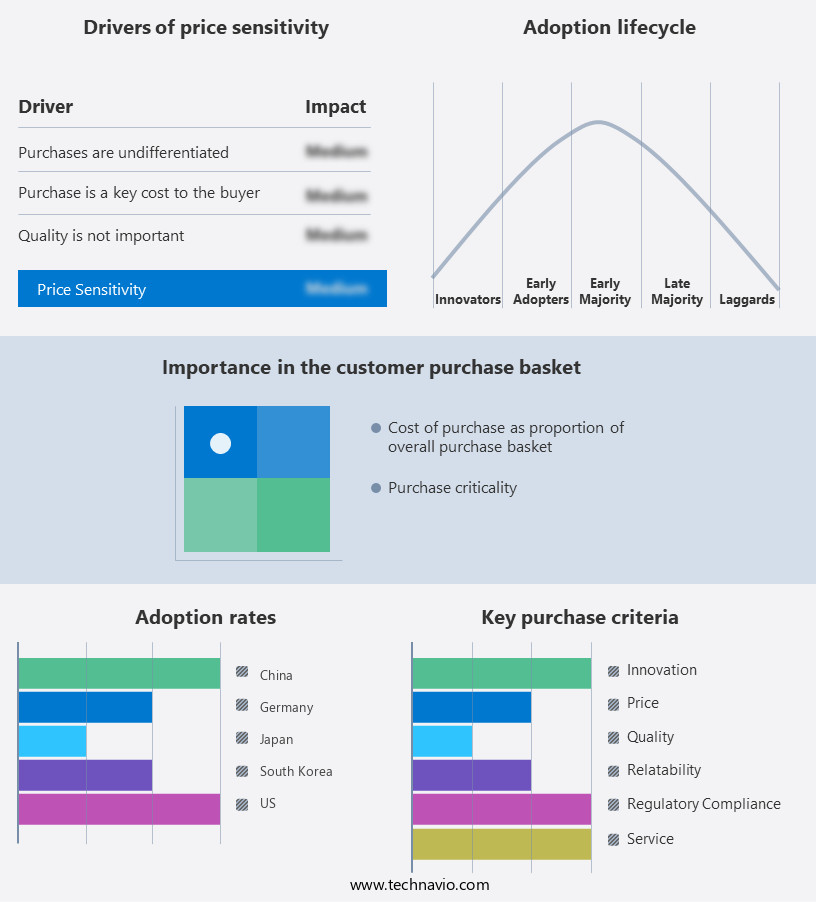
Customer Landscape of Air Conditioning (AC) Industry
Competitive Landscape
Companies are implementing various strategies, such as strategic alliances, air conditioning (ac) market forecast, partnerships, mergers and acquisitions, geographical expansion, and product/service launches, to enhance their presence in the industry.
Blue Star Ltd. - This company specializes in providing fixed speed split air conditioning solutions, delivering efficient and effective climate control for various applications. Their product offerings cater to diverse cooling needs with a focus on energy efficiency and reliability.
The industry research and growth report includes detailed analyses of the competitive landscape of the market and information about key companies, including:
- Blue Star Ltd.
- Daikin Industries Ltd.
- DeLonghi Group
- Electrolux group
- Emerson Electric Co.
- Fujitsu Ltd.
- Haier Smart Home Co. Ltd.
- Hitachi Ltd.
- Honeywell International Inc.
- Johnson Controls International Plc
- LG Corp.
- MIDEA Group Co. Ltd.
- Mitsubishi Electric Corp.
- Panasonic Holdings Corp.
- Samsung Electronics Co. Ltd.
- Toshiba Corp.
- Trane Technologies Plc
- Transform Holdco LLC
- Voltas Ltd.
- Whirlpool Corp.
Qualitative and quantitative analysis of companies has been conducted to help clients understand the wider business environment as well as the strengths and weaknesses of key industry players. Data is qualitatively analyzed to categorize companies as pure play, category-focused, industry-focused, and diversified; it is quantitatively analyzed to categorize companies as dominant, leading, strong, tentative, and weak.
Recent Development and News in Air Conditioning (AC) Market
- In January 2024, Carrier Global Corporation, a leading player in the air conditioning market, announced the launch of its new line of energy-efficient residential air conditioners, the Infinity Touch Series. This innovative product line, featuring advanced technologies such as Greenspeed intelligence and a touchscreen control, was designed to enhance user experience and reduce energy consumption (Carrier Global Corporation Press Release, 2024).
- In March 2024, LG Electronics and Amazon announced a strategic partnership to integrate LG's ThinQ AI technology into Amazon's Alexa voice assistant. This collaboration aimed to provide customers with more convenient and efficient air conditioning control, further popularizing smart home solutions (LG Electronics Press Release, 2024).
- In May 2024, Daikin Industries, Ltd. Completed the acquisition of FAGRAS S.P.A., a leading Italian manufacturer of air conditioning and refrigeration systems. This strategic move expanded Daikin's European market presence and strengthened its product portfolio (Daikin Industries, Ltd. Press Release, 2024).
- In August 2024, the European Union passed the new Ecodesign Regulation, setting stricter energy efficiency standards for air conditioners and other appliances. The new regulation, which took effect in January 2025, is expected to drive the market towards more energy-efficient solutions (European Commission Press Release, 2024).
Dive into Technavio's robust research methodology, blending expert interviews, extensive data synthesis, and validated models for unparalleled Air Conditioning (AC) Market insights. See full methodology.
|
Market Scope
|
|
Report Coverage
|
Details
|
|
Page number
|
230
|
|
Base year
|
2024
|
|
Historic period
|
2019-2023 |
|
Forecast period
|
2025-2029
|
|
Growth momentum & CAGR
|
Accelerate at a CAGR of 2%
|
|
Market growth 2025-2029
|
USD 14.12 billion
|
|
Market structure
|
Fragmented
|
|
YoY growth 2024-2025(%)
|
1.8
|
|
Key countries
|
US, China, Japan, India, South Korea, UK, Canada, Germany, Australia, and France
|
|
Competitive landscape
|
Leading Companies, Market Positioning of Companies, Competitive Strategies, and Industry Risks
|
Request Free Sample
Research Analyst Overview
- The market continues to evolve, driven by advancements in technology and shifting consumer preferences. Building envelope design plays a crucial role in AC system efficiency, with thermal insulation methods and heat pump technology being key areas of focus. HVAC maintenance schedules and remote monitoring systems ensure optimal condenser performance and refrigerant lifecycle management. Air handling units and energy modeling software facilitate thermal comfort modeling and energy efficiency ratings, while dehumidification processes and load calculations help optimize cooling capacity metrics. Variable refrigerant flow and compressor technology enhance system control strategies, reducing energy consumption data and improving refrigerant efficiency.
- Indoor air quality is a growing concern, leading to the integration of air filtration technology and air quality sensors. Chilled water systems and cooling tower operation require ongoing attention, with energy efficiency ratings and cooling capacity metrics shaping industry expectations. Smart thermostat integration and duct design optimization further contribute to market dynamism. For instance, a leading construction firm reported a 25% increase in energy savings by implementing ductless mini-split systems and optimizing air distribution systems in their latest project. The global AC market is projected to grow by 5% annually, fueled by the adoption of advanced technologies and increasing demand for energy-efficient solutions.
What are the Key Data Covered in this Air Conditioning (AC) Market Research and Growth Report?
-
What is the expected growth of the Air Conditioning (AC) Market between 2025 and 2029?
-
What segmentation does the market report cover?
-
The report is segmented by Product (Split, Chillers, Airside, and Others), Distribution Channel (Offline and Online), End-user (Residential, Commercial, and Industrial), and Geography (APAC, Europe, North America, Middle East and Africa, and South America)
-
Which regions are analyzed in the report?
-
APAC, Europe, North America, Middle East and Africa, and South America
-
What are the key growth drivers and market challenges?
-
Who are the major players in the Air Conditioning (AC) Market?
-
Blue Star Ltd., Daikin Industries Ltd., DeLonghi Group, Electrolux group, Emerson Electric Co., Fujitsu Ltd., Haier Smart Home Co. Ltd., Hitachi Ltd., Honeywell International Inc., Johnson Controls International Plc, LG Corp., MIDEA Group Co. Ltd., Mitsubishi Electric Corp., Panasonic Holdings Corp., Samsung Electronics Co. Ltd., Toshiba Corp., Trane Technologies Plc, Transform Holdco LLC, Voltas Ltd., and Whirlpool Corp.
Market Research Insights
- The market for air conditioning (AC) systems is a dynamic and ever-evolving industry. Two significant data points illustrate its continuous growth and evolution. First, the global market for variable speed drives in HVAC systems is projected to expand at a steady rate, reaching over 30 billion US dollars by 2025. This growth is driven by the increasing demand for energy efficiency and cost savings in building operations. Second, retrofit solutions for HVAC systems are gaining traction, with industry experts anticipating a growth rate of approximately 5% annually.
- For instance, a large commercial building in New York City implemented a retrofit project, resulting in a 20% reduction in energy consumption and a corresponding cost savings of millions of dollars per year. These figures underscore the potential for significant improvements in system efficiency and overall cost reduction through the adoption of advanced technologies and solutions in the AC market.
We can help! Our analysts can customize this air conditioning (AC) market research report to meet your requirements.
Get in touch
1 Executive Summary
- 1.1 Market overview
- Executive Summary - Chart on Market Overview
- Executive Summary - Data Table on Market Overview
- Executive Summary - Chart on Global Market Characteristics
- Executive Summary - Chart on Market by Geography
- Executive Summary - Chart on Market Segmentation by Product
- Executive Summary - Chart on Market Segmentation by Distribution Channel
- Executive Summary - Chart on Market Segmentation by End-user
- Executive Summary - Chart on Incremental Growth
- Executive Summary - Data Table on Incremental Growth
- Executive Summary - Chart on Company Market Positioning
2 Technavio Analysis
- 2.1 Analysis of price sensitivity, lifecycle, customer purchase basket, adoption rates, and purchase criteria
- Analysis of price sensitivity, lifecycle, customer purchase basket, adoption rates, and purchase criteria
- 2.2 Criticality of inputs and Factors of differentiation
- Overview on criticality of inputs and factors of differentiation
- 2.3 Factors of disruption
- Overview on factors of disruption
- 2.4 Impact of drivers and challenges
- Impact of drivers and challenges in 2024 and 2029
3 Market Landscape
- 3.1 Market ecosystem
- Parent Market
- Data Table on - Parent Market
- 3.2 Market characteristics
- Market characteristics analysis
4 Market Sizing
- 4.1 Market definition
- Offerings of companies included in the market definition
- 4.2 Market segment analysis
- 4.4 Market outlook: Forecast for 2024-2029
- Chart on Global - Market size and forecast 2024-2029 ($ million)
- Data Table on Global - Market size and forecast 2024-2029 ($ million)
- Chart on Global Market: Year-over-year growth 2024-2029 (%)
- Data Table on Global Market: Year-over-year growth 2024-2029 (%)
5 Historic Market Size
- 5.1 Global Air Conditioning (AC) Market 2019 - 2023
- Historic Market Size - Data Table on Global Air Conditioning (AC) Market 2019 - 2023 ($ million)
- 5.2 Product segment analysis 2019 - 2023
- Historic Market Size - Product Segment 2019 - 2023 ($ million)
- 5.3 Distribution Channel segment analysis 2019 - 2023
- Historic Market Size - Distribution Channel Segment 2019 - 2023 ($ million)
- 5.4 End-user segment analysis 2019 - 2023
- Historic Market Size - End-user Segment 2019 - 2023 ($ million)
- 5.5 Geography segment analysis 2019 - 2023
- Historic Market Size - Geography Segment 2019 - 2023 ($ million)
- 5.6 Country segment analysis 2019 - 2023
- Historic Market Size - Country Segment 2019 - 2023 ($ million)
6 Qualitative Analysis
- 6.1 Impact of AI on the Global Air Conditioning (AC) Market
7 Five Forces Analysis
- 7.1 Five forces summary
- Five forces analysis - Comparison between 2024 and 2029
- 7.2 Bargaining power of buyers
- Bargaining power of buyers - Impact of key factors 2024 and 2029
- 7.3 Bargaining power of suppliers
- Bargaining power of suppliers - Impact of key factors in 2024 and 2029
- 7.4 Threat of new entrants
- Threat of new entrants - Impact of key factors in 2024 and 2029
- 7.5 Threat of substitutes
- Threat of substitutes - Impact of key factors in 2024 and 2029
- 7.6 Threat of rivalry
- Threat of rivalry - Impact of key factors in 2024 and 2029
- 7.7 Market condition
- Chart on Market condition - Five forces 2024 and 2029
8 Market Segmentation by Product
- 8.1 Market segments
- Chart on Product - Market share 2024-2029 (%)
- Data Table on Product - Market share 2024-2029 (%)
- 8.2 Comparison by Product
- Chart on Comparison by Product
- Data Table on Comparison by Product
- 8.3 Split - Market size and forecast 2024-2029
- Chart on Split - Market size and forecast 2024-2029 ($ million)
- Data Table on Split - Market size and forecast 2024-2029 ($ million)
- Chart on Split - Year-over-year growth 2024-2029 (%)
- Data Table on Split - Year-over-year growth 2024-2029 (%)
- 8.4 Chillers - Market size and forecast 2024-2029
- Chart on Chillers - Market size and forecast 2024-2029 ($ million)
- Data Table on Chillers - Market size and forecast 2024-2029 ($ million)
- Chart on Chillers - Year-over-year growth 2024-2029 (%)
- Data Table on Chillers - Year-over-year growth 2024-2029 (%)
- 8.5 Airside - Market size and forecast 2024-2029
- Chart on Airside - Market size and forecast 2024-2029 ($ million)
- Data Table on Airside - Market size and forecast 2024-2029 ($ million)
- Chart on Airside - Year-over-year growth 2024-2029 (%)
- Data Table on Airside - Year-over-year growth 2024-2029 (%)
- 8.6 Others - Market size and forecast 2024-2029
- Chart on Others - Market size and forecast 2024-2029 ($ million)
- Data Table on Others - Market size and forecast 2024-2029 ($ million)
- Chart on Others - Year-over-year growth 2024-2029 (%)
- Data Table on Others - Year-over-year growth 2024-2029 (%)
- 8.7 Market opportunity by Product
- Market opportunity by Product ($ million)
- Data Table on Market opportunity by Product ($ million)
9 Market Segmentation by Distribution Channel
- 9.1 Market segments
- Chart on Distribution Channel - Market share 2024-2029 (%)
- Data Table on Distribution Channel - Market share 2024-2029 (%)
- 9.2 Comparison by Distribution Channel
- Chart on Comparison by Distribution Channel
- Data Table on Comparison by Distribution Channel
- 9.3 Offline - Market size and forecast 2024-2029
- Chart on Offline - Market size and forecast 2024-2029 ($ million)
- Data Table on Offline - Market size and forecast 2024-2029 ($ million)
- Chart on Offline - Year-over-year growth 2024-2029 (%)
- Data Table on Offline - Year-over-year growth 2024-2029 (%)
- 9.4 Online - Market size and forecast 2024-2029
- Chart on Online - Market size and forecast 2024-2029 ($ million)
- Data Table on Online - Market size and forecast 2024-2029 ($ million)
- Chart on Online - Year-over-year growth 2024-2029 (%)
- Data Table on Online - Year-over-year growth 2024-2029 (%)
- 9.5 Market opportunity by Distribution Channel
- Market opportunity by Distribution Channel ($ million)
- Data Table on Market opportunity by Distribution Channel ($ million)
10 Market Segmentation by End-user
- 10.1 Market segments
- Chart on End-user - Market share 2024-2029 (%)
- Data Table on End-user - Market share 2024-2029 (%)
- 10.2 Comparison by End-user
- Chart on Comparison by End-user
- Data Table on Comparison by End-user
- 10.3 Residential - Market size and forecast 2024-2029
- Chart on Residential - Market size and forecast 2024-2029 ($ million)
- Data Table on Residential - Market size and forecast 2024-2029 ($ million)
- Chart on Residential - Year-over-year growth 2024-2029 (%)
- Data Table on Residential - Year-over-year growth 2024-2029 (%)
- 10.4 Commercial - Market size and forecast 2024-2029
- Chart on Commercial - Market size and forecast 2024-2029 ($ million)
- Data Table on Commercial - Market size and forecast 2024-2029 ($ million)
- Chart on Commercial - Year-over-year growth 2024-2029 (%)
- Data Table on Commercial - Year-over-year growth 2024-2029 (%)
- 10.5 Industrial - Market size and forecast 2024-2029
- Chart on Industrial - Market size and forecast 2024-2029 ($ million)
- Data Table on Industrial - Market size and forecast 2024-2029 ($ million)
- Chart on Industrial - Year-over-year growth 2024-2029 (%)
- Data Table on Industrial - Year-over-year growth 2024-2029 (%)
- 10.6 Market opportunity by End-user
- Market opportunity by End-user ($ million)
- Data Table on Market opportunity by End-user ($ million)
11 Customer Landscape
- 11.1 Customer landscape overview
- Analysis of price sensitivity, lifecycle, customer purchase basket, adoption rates, and purchase criteria
12 Geographic Landscape
- 12.1 Geographic segmentation
- Chart on Market share by geography 2024-2029 (%)
- Data Table on Market share by geography 2024-2029 (%)
- 12.2 Geographic comparison
- Chart on Geographic comparison
- Data Table on Geographic comparison
- 12.3 APAC - Market size and forecast 2024-2029
- Chart on APAC - Market size and forecast 2024-2029 ($ million)
- Data Table on APAC - Market size and forecast 2024-2029 ($ million)
- Chart on APAC - Year-over-year growth 2024-2029 (%)
- Data Table on APAC - Year-over-year growth 2024-2029 (%)
- 12.4 Europe - Market size and forecast 2024-2029
- Chart on Europe - Market size and forecast 2024-2029 ($ million)
- Data Table on Europe - Market size and forecast 2024-2029 ($ million)
- Chart on Europe - Year-over-year growth 2024-2029 (%)
- Data Table on Europe - Year-over-year growth 2024-2029 (%)
- 12.5 North America - Market size and forecast 2024-2029
- Chart on North America - Market size and forecast 2024-2029 ($ million)
- Data Table on North America - Market size and forecast 2024-2029 ($ million)
- Chart on North America - Year-over-year growth 2024-2029 (%)
- Data Table on North America - Year-over-year growth 2024-2029 (%)
- 12.6 Middle East and Africa - Market size and forecast 2024-2029
- Chart on Middle East and Africa - Market size and forecast 2024-2029 ($ million)
- Data Table on Middle East and Africa - Market size and forecast 2024-2029 ($ million)
- Chart on Middle East and Africa - Year-over-year growth 2024-2029 (%)
- Data Table on Middle East and Africa - Year-over-year growth 2024-2029 (%)
- 12.7 South America - Market size and forecast 2024-2029
- Chart on South America - Market size and forecast 2024-2029 ($ million)
- Data Table on South America - Market size and forecast 2024-2029 ($ million)
- Chart on South America - Year-over-year growth 2024-2029 (%)
- Data Table on South America - Year-over-year growth 2024-2029 (%)
- 12.8 US - Market size and forecast 2024-2029
- Chart on US - Market size and forecast 2024-2029 ($ million)
- Data Table on US - Market size and forecast 2024-2029 ($ million)
- Chart on US - Year-over-year growth 2024-2029 (%)
- Data Table on US - Year-over-year growth 2024-2029 (%)
- 12.9 China - Market size and forecast 2024-2029
- Chart on China - Market size and forecast 2024-2029 ($ million)
- Data Table on China - Market size and forecast 2024-2029 ($ million)
- Chart on China - Year-over-year growth 2024-2029 (%)
- Data Table on China - Year-over-year growth 2024-2029 (%)
- 12.10 Japan - Market size and forecast 2024-2029
- Chart on Japan - Market size and forecast 2024-2029 ($ million)
- Data Table on Japan - Market size and forecast 2024-2029 ($ million)
- Chart on Japan - Year-over-year growth 2024-2029 (%)
- Data Table on Japan - Year-over-year growth 2024-2029 (%)
- 12.11 India - Market size and forecast 2024-2029
- Chart on India - Market size and forecast 2024-2029 ($ million)
- Data Table on India - Market size and forecast 2024-2029 ($ million)
- Chart on India - Year-over-year growth 2024-2029 (%)
- Data Table on India - Year-over-year growth 2024-2029 (%)
- 12.12 South Korea - Market size and forecast 2024-2029
- Chart on South Korea - Market size and forecast 2024-2029 ($ million)
- Data Table on South Korea - Market size and forecast 2024-2029 ($ million)
- Chart on South Korea - Year-over-year growth 2024-2029 (%)
- Data Table on South Korea - Year-over-year growth 2024-2029 (%)
- 12.13 UK - Market size and forecast 2024-2029
- Chart on UK - Market size and forecast 2024-2029 ($ million)
- Data Table on UK - Market size and forecast 2024-2029 ($ million)
- Chart on UK - Year-over-year growth 2024-2029 (%)
- Data Table on UK - Year-over-year growth 2024-2029 (%)
- 12.14 Canada - Market size and forecast 2024-2029
- Chart on Canada - Market size and forecast 2024-2029 ($ million)
- Data Table on Canada - Market size and forecast 2024-2029 ($ million)
- Chart on Canada - Year-over-year growth 2024-2029 (%)
- Data Table on Canada - Year-over-year growth 2024-2029 (%)
- 12.15 Germany - Market size and forecast 2024-2029
- Chart on Germany - Market size and forecast 2024-2029 ($ million)
- Data Table on Germany - Market size and forecast 2024-2029 ($ million)
- Chart on Germany - Year-over-year growth 2024-2029 (%)
- Data Table on Germany - Year-over-year growth 2024-2029 (%)
- 12.16 Australia - Market size and forecast 2024-2029
- Chart on Australia - Market size and forecast 2024-2029 ($ million)
- Data Table on Australia - Market size and forecast 2024-2029 ($ million)
- Chart on Australia - Year-over-year growth 2024-2029 (%)
- Data Table on Australia - Year-over-year growth 2024-2029 (%)
- 12.17 France - Market size and forecast 2024-2029
- Chart on France - Market size and forecast 2024-2029 ($ million)
- Data Table on France - Market size and forecast 2024-2029 ($ million)
- Chart on France - Year-over-year growth 2024-2029 (%)
- Data Table on France - Year-over-year growth 2024-2029 (%)
- 12.18 Market opportunity by geography
- Market opportunity by geography ($ million)
- Data Tables on Market opportunity by geography ($ million)
13 Drivers, Challenges, and Opportunity/Restraints
- 13.3 Impact of drivers and challenges
- Impact of drivers and challenges in 2024 and 2029
- 13.4 Market opportunities/restraints
14 Competitive Landscape
- 14.2 Competitive Landscape
- Overview on criticality of inputs and factors of differentiation
- 14.3 Landscape disruption
- Overview on factors of disruption
- 14.4 Industry risks
- Impact of key risks on business
15 Competitive Analysis
- 15.2 Company ranking index
- 15.3 Market positioning of companies
- Matrix on companies position and classification
- 15.4 Blue Star Ltd.
- Blue Star Ltd. - Overview
- Blue Star Ltd. - Business segments
- Blue Star Ltd. - Key news
- Blue Star Ltd. - Key offerings
- Blue Star Ltd. - Segment focus
- SWOT
- 15.5 Daikin Industries Ltd.
- Daikin Industries Ltd. - Overview
- Daikin Industries Ltd. - Business segments
- Daikin Industries Ltd. - Key news
- Daikin Industries Ltd. - Key offerings
- Daikin Industries Ltd. - Segment focus
- SWOT
- 15.6 DeLonghi Group
- DeLonghi Group - Overview
- DeLonghi Group - Business segments
- DeLonghi Group - Key offerings
- DeLonghi Group - Segment focus
- SWOT
- 15.7 Electrolux group
- Electrolux group - Overview
- Electrolux group - Business segments
- Electrolux group - Key news
- Electrolux group - Key offerings
- Electrolux group - Segment focus
- SWOT
- 15.8 Fujitsu Ltd.
- Fujitsu Ltd. - Overview
- Fujitsu Ltd. - Business segments
- Fujitsu Ltd. - Key news
- Fujitsu Ltd. - Key offerings
- Fujitsu Ltd. - Segment focus
- SWOT
- 15.9 Haier Smart Home Co. Ltd.
- Haier Smart Home Co. Ltd. - Overview
- Haier Smart Home Co. Ltd. - Business segments
- Haier Smart Home Co. Ltd. - Key offerings
- Haier Smart Home Co. Ltd. - Segment focus
- SWOT
- 15.10 Honeywell International Inc.
- Honeywell International Inc. - Overview
- Honeywell International Inc. - Business segments
- Honeywell International Inc. - Key news
- Honeywell International Inc. - Key offerings
- Honeywell International Inc. - Segment focus
- SWOT
- 15.11 Johnson Controls International Plc
- Johnson Controls International Plc - Overview
- Johnson Controls International Plc - Business segments
- Johnson Controls International Plc - Key news
- Johnson Controls International Plc - Key offerings
- Johnson Controls International Plc - Segment focus
- SWOT
- 15.12 LG Corp.
- LG Corp. - Overview
- LG Corp. - Product / Service
- LG Corp. - Key offerings
- SWOT
- 15.13 Mitsubishi Electric Corp.
- Mitsubishi Electric Corp. - Overview
- Mitsubishi Electric Corp. - Business segments
- Mitsubishi Electric Corp. - Key offerings
- Mitsubishi Electric Corp. - Segment focus
- SWOT
- 15.14 Panasonic Holdings Corp.
- Panasonic Holdings Corp. - Overview
- Panasonic Holdings Corp. - Business segments
- Panasonic Holdings Corp. - Key news
- Panasonic Holdings Corp. - Key offerings
- Panasonic Holdings Corp. - Segment focus
- SWOT
- 15.15 Samsung Electronics Co. Ltd.
- Samsung Electronics Co. Ltd. - Overview
- Samsung Electronics Co. Ltd. - Business segments
- Samsung Electronics Co. Ltd. - Key news
- Samsung Electronics Co. Ltd. - Key offerings
- Samsung Electronics Co. Ltd. - Segment focus
- SWOT
- 15.16 Toshiba Corp.
- Toshiba Corp. - Overview
- Toshiba Corp. - Business segments
- Toshiba Corp. - Key news
- Toshiba Corp. - Key offerings
- Toshiba Corp. - Segment focus
- SWOT
- 15.17 Transform Holdco LLC
- Transform Holdco LLC - Overview
- Transform Holdco LLC - Product / Service
- Transform Holdco LLC - Key offerings
- SWOT
- 15.18 Whirlpool Corp.
- Whirlpool Corp. - Overview
- Whirlpool Corp. - Business segments
- Whirlpool Corp. - Key offerings
- Whirlpool Corp. - Segment focus
- SWOT
16 Appendix
- 16.2 Inclusions and exclusions checklist
- Inclusions checklist
- Exclusions checklist
- 16.3 Currency conversion rates for US$
- Currency conversion rates for US$
- 16.4 Research methodology
- 16.7 Validation techniques employed for market sizing
- Validation techniques employed for market sizing
- 16.9 360 degree market analysis
- 360 degree market analysis
- 16.10 List of abbreviations







![]() Get the report (PDF) sent to your email within minutes.
Get the report (PDF) sent to your email within minutes.
Complimentary full Excel data with your report purchase.